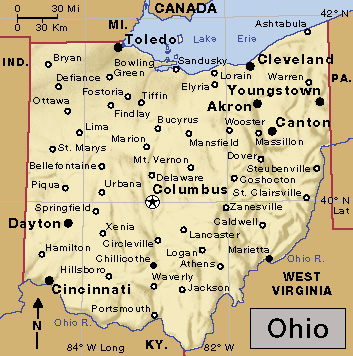Akron (pop. 190,469; met. area pop. 702,219) is a city in northeastern Ohio. It lies on the Cuyahoga and Little Cuyahoga rivers.

Akron was once the world’s largest producer of tires, and it was known as the Rubber Capital of the World. Today, the city is a center for the research and development of rubber products. The Goodyear Tire & Rubber Company—one of the largest rubber companies in the United States—has its main office in Akron.
The city.
Downtown Akron includes a federal courthouse and state government offices. A sports stadium is also located in the downtown area. A restaurant and entertainment district has developed around the stadium.
The former Goodyear Airdock, also called the Akron Airdock, is a well-known feature of the Akron skyline. It is the building where Goodyear once built blimps. It stands more than 20 stories tall and covers 364,000 square feet (33,800 square meters) of floor space. It is one of the world’s largest buildings without interior supports.
Akron’s cultural attractions include the Akron Art Museum, which specializes in modern art, and the Akron Civic Theatre, built in 1929. Stan Hywet Hall, a mansion built by Goodyear founder F. A. Seiberling, is now used for cultural events. The Akron Symphony Orchestra performs at the Akron Civic Theatre and at E. J. Thomas Performing Arts Hall. Blossom Music Center, north of the city in Cuyahoga Falls, is the summer home of the Cleveland Orchestra and hosts other musical performances. Akron is host each year to the All-American Soap Box Derby (see Soap Box Derby).
The University of Akron is in downtown Akron. Kent State University is northeast of Akron in Kent. The Northeast Ohio Medical University is to the east of Akron in Rootstown.
Economy.
Akron is a center for the research and development of rubber products. Service industries, such as health care and retail trade, are also important in Akron. The city has several hospitals and serves as a medical center for the region. It is also an important trucking center.
Akron-Canton Airport and Akron Fulton International Airport serve the city. Passenger trains and freight trains also serve Akron.
Government.
Akron has a mayor-council form of government. The voters elect the mayor to a four-year term. They also elect 13 council members to four-year terms. Ten of the members represent different sections of the city and three of the members represent the entire city. Akron is the seat of Summit County.
History.
Chippewa, Delaware, Erie, and several other Native American groups lived in what is now the Akron area. In 1825, General Simon Perkins, a banker, developer, and land agent, and settler Paul Williams founded Akron on a ridge that rises 950 feet (290 meters) above sea level. The settlement was named after the Greek word akros, meaning high point. Akron became a thriving trade center after the completion of the Ohio and Erie Canal in 1832 and the Pennsylvania and Ohio Canal in 1840. The canals opened the way for increased trade with cities in the eastern United States. Akron was incorporated in 1865.
In the 1800’s, Akron was a center for the production of cereal, clay pipe, and farm equipment, but it was rubber that made it famous. In 1870, Benjamin F. Goodrich, a New York doctor and rubber manufacturer, moved to Akron and established a rubber factory. Several other rubber companies later built factories in Akron, and the city grew rapidly. The development of the automobile industry in the early 1900’s created a huge demand for rubber tires. Akron became the world’s leading tire producer. The city’s population soared, rising from about 70,000 in 1910 to nearly 210,000 in 1920. Military needs during World War II (1939-1945) led to an even greater demand for Akron’s tires and other rubber products.
Rubber remained the city’s main industry until about the 1970’s. During the 1970’s and 1980’s, Akron, like other older cities of the North, lost many jobs and people to newer factories in the South and Southwest. In the late 1900’s, the city worked to diversify its manufacturing base and to redevelop its downtown. Today, many small businesses occupy the buildings once dominated by the rubber industry.
